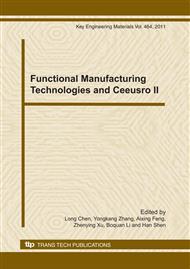p.568
p.572
p.576
p.583
p.588
p.592
p.596
p.600
p.605
Theoretical Calculation and Numerical Analysis of Residual Stress in Laser Peen Forming of Metal Plate
Abstract:
Laser peen forming is an emerging novel process of metal plate bending, which uses laser-induced shock wave pressure to generate an unbalanced residual stress field in the target, the moment of the residual stress causes metal plate to develop plastic bending deformation. The mechanism of laser shock induced residual stress was introduced firstly, then the deforming process of metal plate induced by residual stresses was discussed and the depth of the residual compressive stress was proposed. Effects of processing parameters on the residual stress distribution and plate bending deformation were numerical analyzed. The results indicated that the bending deformation of sheet was relative to laser peening numbers, peening coverage and thickness of plate, the magnitude and distribution of residual stresses could be precisely controlled by adjusting laser processing parameters.
Info:
Periodical:
Pages:
588-591
Citation:
Online since:
January 2011
Authors:
Price:
Сopyright:
© 2011 Trans Tech Publications Ltd. All Rights Reserved
Share:
Citation:


